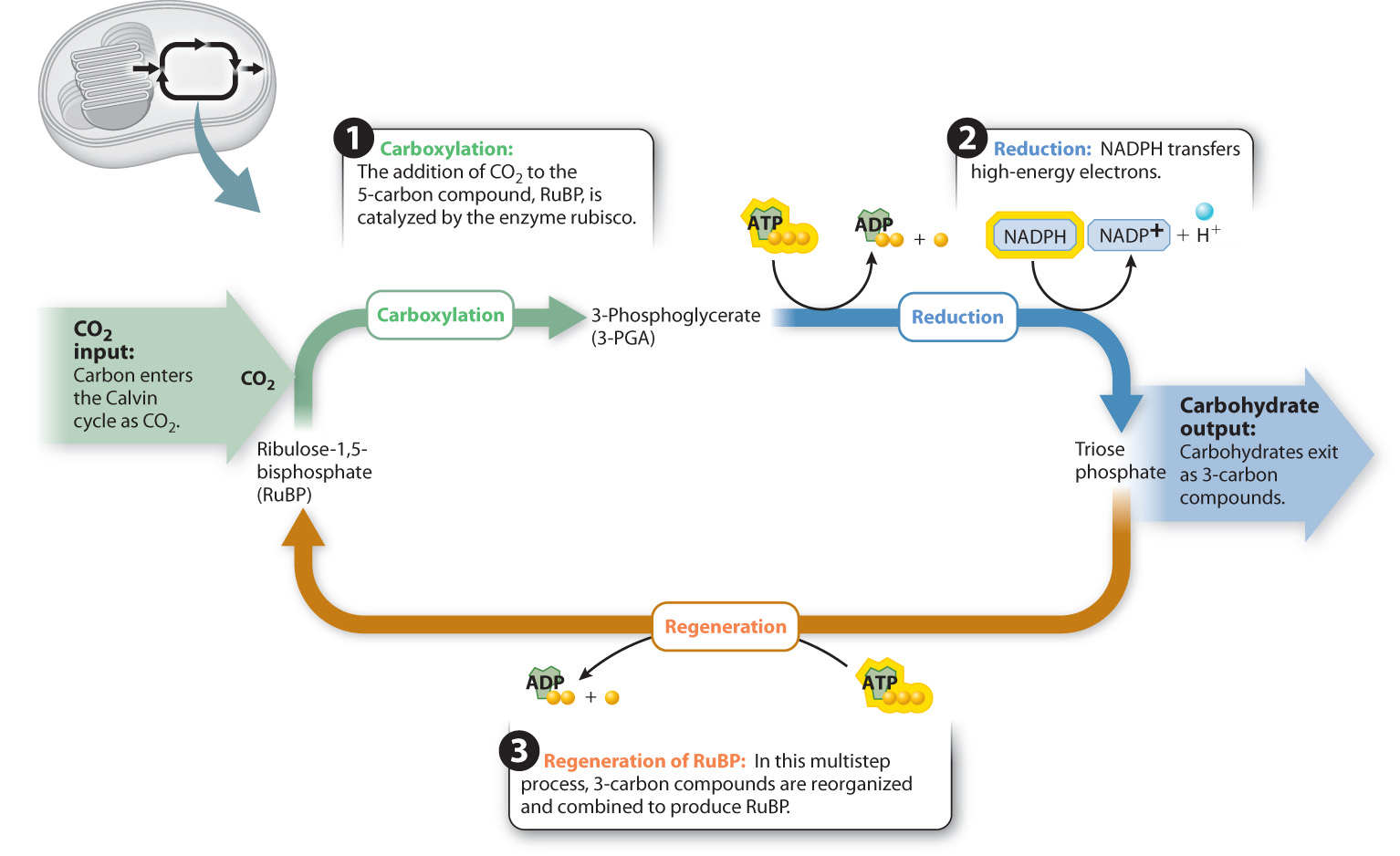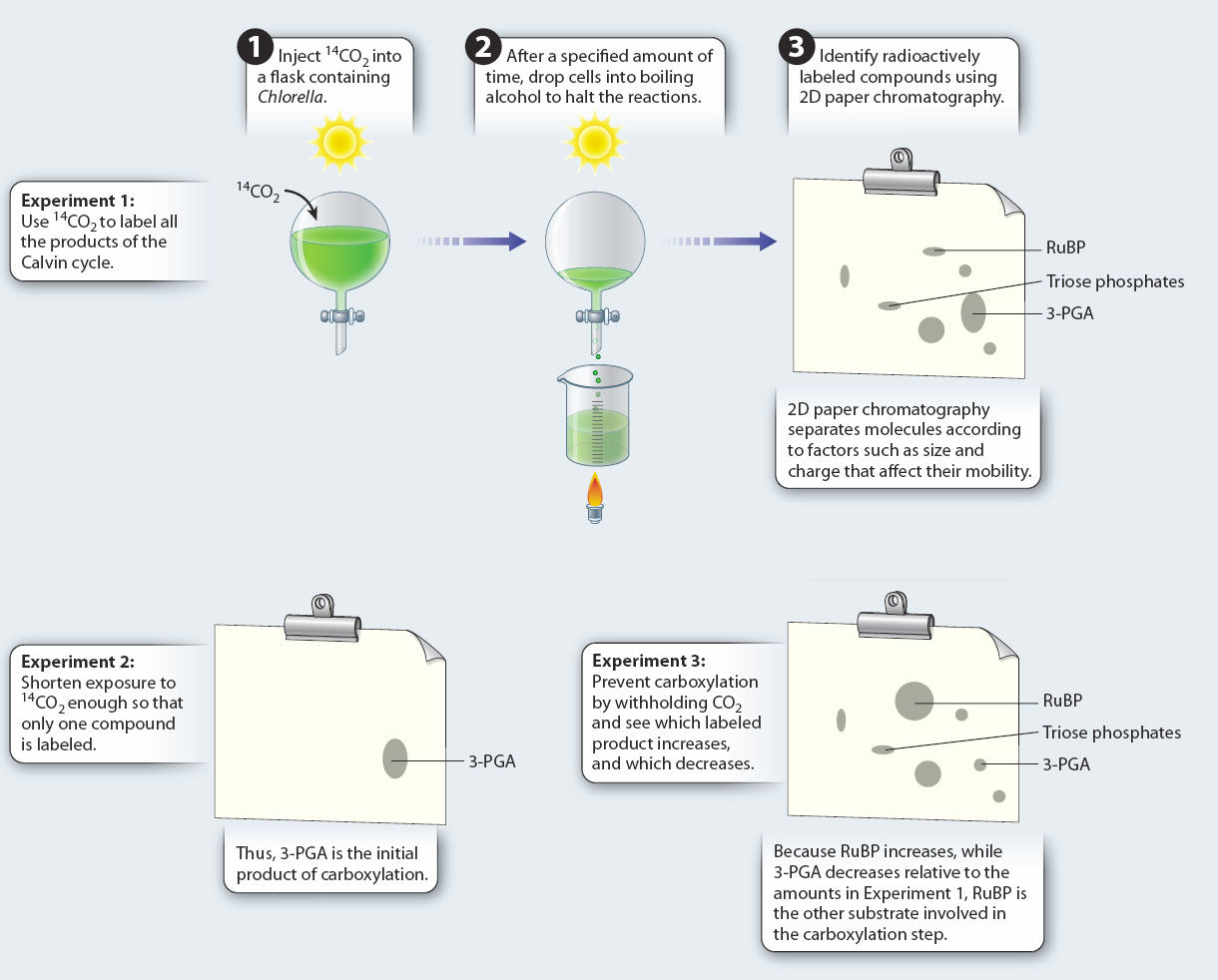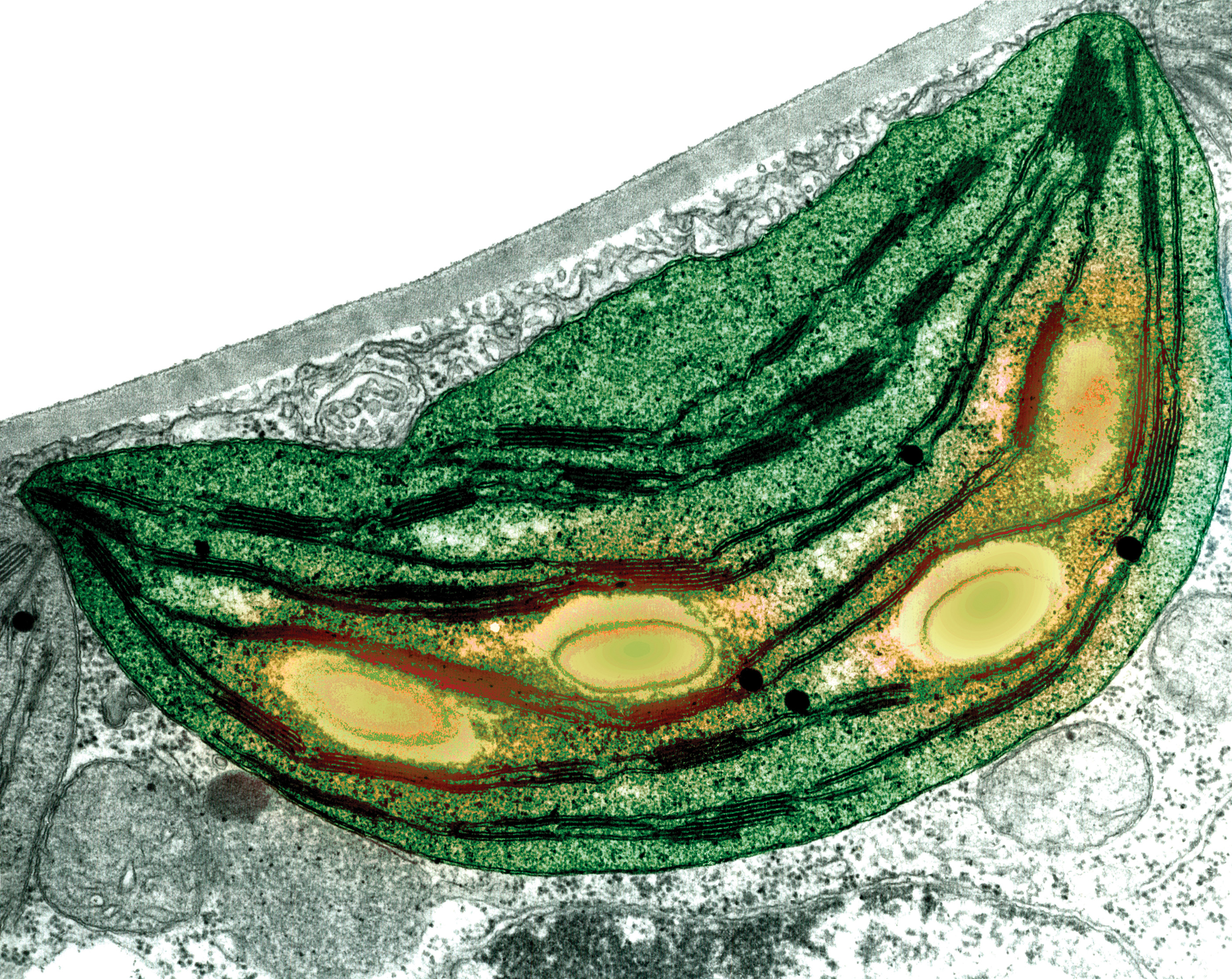8.2 THE CALVIN CYCLE
The Calvin cycle consists of 15 chemical reactions that synthesize carbohydrates from CO2. These reactions can be grouped into three main steps: (1) carboxylation, in which CO2 absorbed from the air is added to a 5‑carbon molecule; (2) reduction, in which energy and electrons are transferred to the molecules formed from carboxylation; and (3) regeneration of the 5‑carbon molecule needed for carboxylation (Fig. 8.6).

8.2.1 The incorporation of CO₂ is catalyzed by the enzyme rubisco.
The first step of the Calvin cycle is a carboxylation reaction (Fig. 8.6). Specifically, CO2 is added to a 5-carbon sugar called ribulose-1,5-bisphosphate (RuBP). This step is catalyzed by the enzyme ribulose bisphosphate carboxylase oxygenase, or rubisco for short. Although many enzymes are active in the Calvin cycle, rubisco has a disproportionate influence over the functioning of the entire pathway.
Compared to other enzymes, rubisco is surprisingly slow. As a result, photosynthetic cells must produce large amounts of this single enzyme. In fact, rubisco is the most abundant protein on Earth and constitutes as much as half of the total protein found in a leaf. As the principal gatekeeper through which CO2 becomes incorporated into carbohydrates, rubisco plays a key role in the processes that permit life on Earth.
Before rubisco can act as a carboxylase, RuBP and CO2 must diffuse into its active site. Once the active site is occupied, carboxylation proceeds spontaneously. The product is a 6-carbon compound that immediately breaks into two molecules of 3-phosphoglycerate (3-PGA). These 3-carbon molecules are the first stable products of the Calvin cycle. However, if O2 instead of CO2 diffuses into the active site, the reaction can still proceed, although O2 is added to RuBP in place of CO2. An enzyme like rubisco that adds O2 to a substrate molecule is called an oxygenase, explaining part of this enzyme’s long name. The addition of O2 by rubisco creates a major challenge for photosynthesis, a topic we discuss in section 8.4.
8.2.2 NADPH is the reducing agent of the Calvin cycle.
Rubisco is responsible for the addition of the carbon atoms needed for the formation of carbohydrates, but by itself rubisco does not increase the amount of energy stored within the newly formed bonds. For this energy increase to take place, the carbon compounds formed by rubisco must be reduced. Nicotinamide adenine dinucleotide phosphate (NADPH) is the reducing agent used in the Calvin cycle. NADPH transfers the energy and electrons that allow carbohydrates to be synthesized from CO2, the most oxidized of all carbon compounds (Fig. 8.6).
NADPH is produced by the photosynthetic electron transport chain. Like all components of the Calvin cycle, NADPH can move freely within the stroma of the chloroplast. Although NADPH is a powerful reducing agent, energy and electrons are transferred from NADPH only under the catalysis of a specific enzyme, thus providing a high degree of control over the fate of these high-energy electrons. In the Calvin cycle, the reduction of 3-PGA involves two steps: (1) ATP is used to phosphorylate 3-PGA, and (2) NADPH transfers two high-energy electrons to the phosphorylated compound. Because two molecules of 3-PGA are formed each time rubisco catalyzes the incorporation of one molecule of CO2, two ATP and two NADPH are required for each molecule of CO2 incorporated by rubisco. NADPH provides most of the energy incorporated in the bonds of the carbohydrate molecules produced by the Calvin cycle. Nevertheless, ATP plays an essential role in preparing 3-PGA for the addition of energy and electrons from NADPH.
These energy transfer steps result in the formation of glyceraldehyde 3-phosphate (GAP), which is reversibly interconverted to dihydroxyacetone phosphate (DHAP) by the enzyme triose phosphate isomerase. Together GAP and DHAP constitute a pool of 3-carbon carbohydrate molecules known as triose phosphates. Triose phosphates are the true products of the Calvin cycle because they are the molecules exported from the chloroplast. Larger sugars, such as glucose and sucrose, are assembled from triose phosphates in the cytoplasm. However, if every triose phosphate molecule produced by the Calvin cycle were exported from the chloroplast, RuBP could not be regenerated and the Calvin cycle would grind to a halt. Thus, for every six triose phosphate molecules that are produced, only one can be withdrawn from the Calvin cycle.
8.2.3 The regeneration of RuBP requires ATP.
Of the 15 chemical reactions that make up the Calvin cycle, 12 are directly involved in the last step, the regeneration of RuBP (Fig. 8.6). The large number of reactions involved in this step reflects the degree of reshuffling of carbon atoms needed to produce three 5-carbon RuBP molecules from five 3-carbon triose phosphate molecules. ATP is required for the regeneration of RuBP, raising the Calvin cycle’s total energy requirements to two molecules of NADPH and three molecules of ATP for each molecule of CO2 incorporated by rubisco. Thus, NADPH and ATP play distinct roles in the formation of carbohydrates from CO2. NADPH provides energy that is incorporated into the higher-energy bonds that characterize carbohydrate molecules, whereas ATP provides energy that is needed to regenerate RuBP.
The Calvin cycle does not utilize sunlight directly. For this reason this pathway is sometimes referred to as the light-independent or even the “dark” reactions of photosynthesis. However, this pathway cannot operate without the energy input provided by a steady supply of NADPH and ATP. Both are supplied by the photosynthetic electron transport chain, in which light is captured and transformed into chemical energy. Thus, under natural conditions, photosynthesis, including the Calvin cycle, occurs only in the light.
Quick Check 2
The Calvin cycle requires both ATP and NADPH. Which of these provides the major input of energy needed to synthesize carbohydrates?
8.2.4 The steps of the Calvin cycle were determined using radioactive CO₂.
In a series of experiments conducted between 1948 and 1954 (Fig. 8.7), the American chemist Melvin Calvin and colleagues supplied radioactively labeled CO2 (14CO2) to the unicellular green alga Chlorella and then plunged the cells into boiling alcohol, thus halting all enzymatic reactions. By examining the compounds that became radioactively labeled, Calvin and his colleagues were able to determine the identity of the carbon compounds produced in photosynthesis (Experiment 1 in Fig. 8.7).
FIG. 8.7How is CO₂ used to synthesize carbohydrates?
BACKGROUND In the 1940s, radioactive 14CO2 became available in quantities that allowed experiments. Melvin Calvin and Andrew Benson used 14CO2 to follow the incorporation of CO2 into
EXPERIMENTS AND RESULTS

CONCLUSION The initial step in the Calvin cycle unites the 5-carbon RuBP with CO2, resulting in the production of two molecules of 3-PGA.
FOLLOW-UP WORK In the 1950s, Marshall Hatch and colleagues showed that some plants, including corn and sugar cane, accumulate a 4-carbon compound as the first product in photosynthesis. In Chapter 29, we explore how C4 photosynthesis allows plants to avoid the oxygenase reaction of rubisco.
SOURCE Calvin, M., and H. Benson. 1949. “The Path of Carbon in Photosynthesis IV: The Identity and Sequence of the Intermediates in Sucrose Synthesis.” Science 109:140–142.
Figuring out the chemical reactions that connected these labeled compounds, however, required both ingenuity and hard work. For example, by using a very short exposure to 14CO2, Calvin and colleagues determined that the incorporation of CO2 results in the production of 3-PGA (Experiment 2 in Fig. 8.7).
To determine how 3-PGA is formed, they supplied radioactive 14CO2 to label the products, but then cut off the supply of 14CO2 to block the carboxylation reaction. In this experiment, the amount of RuBP increased relative to the amount seen in the first experiment. They concluded that the first step was the addition of CO2 to RuBP (Experiment 3 in Fig. 8.7).
8.2.5 Carbohydrates are stored in the form of starch.
The Calvin cycle is capable of producing more carbohydrates than the cell needs or, in a multicellular organism, more than the cell is able to export. If carbohydrates accumulated in the cell, they would upset the osmotic balance, causing water to enter the cell. Instead, excess carbohydrates are converted to starch, a storage form of carbohydrates discussed in Chapter 2. Because starch molecules are not soluble, they provide a means of carbohydrate storage that does not affect the cell’s osmotic balance. The formation of starch during the day provides photosynthetic cells with a source of carbohydrates that they can use during the night (Fig. 8.8).
